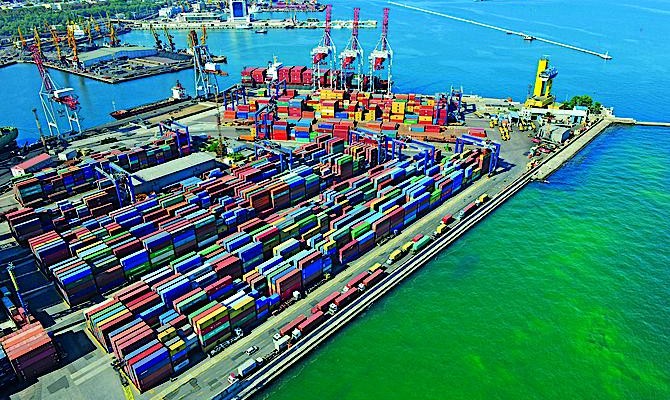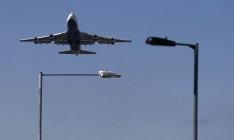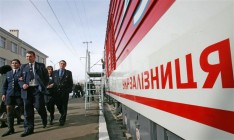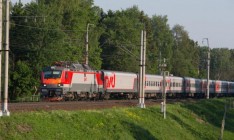Business
transportUkrainian ports are increasing cargo handling, but losing container flows

Commercial seaports (CSP) in continental Ukraine compensated for the loss of Crimean water harbors for the domestic transport industry and continue to see an increase in production. In January–August, the CSPs increased cargo transshipment by 7.1% to 91.2 mn t compared to the same period last year, according to the Administration of Seaports of Ukraine (ASPU).
Despite this, positive results were not observed not in all sectors. While transshipment of exports grew over the aforementioned period by 15.7% to 66.259 mn t, transshipment of imports fell by 15.5% to 9.644 mn t, transit – by 3.6% (to 14.46 mn t) and container traffic fell by 11.2% to 450,400 TEU. Processing of liquid and dry cargo has shown positive growth with their flow having increased by 8.8% to 9.964 mn t and 6.6% to 59.271 mn t, respectively.
They can do better
The overall results of the operation of ports could have been even better if it was not for the decline in processing of ore, coke, construction materials, chemicals and fertilizers, complains Head of the Operations Department at ASPU Yuriy Vlasov analyzing the situation. For example, transshipment of ore dropped by 7.1% (to 21.3 mn t), coke by almost 16% (to 997,000 t), and construction materials and mineral fertilizers by 16.7% (to 2.3 mn t) and 34.5% (2.7 mn t), respectively. Vlasov explained the decline in the transit traffic saying it was aimed mainly at the Ukraine–Russia direction (and vice versa) and now this traffic has fallen due to the situation in the eastern part of the country.
As for container transportation, according to experts it is in decline due to the high cost of maintenance in Ukrainian ports. At the International Black Sea Container Summit 2014, which was recently held in Odesa, President of the Association of Container Lines of Ukraine Stefan Klenchu said the high prices in Ukrainian ports are discouraging new shipping operators from entering the Ukrainian market. This has already resulted in Ukraine’s loss of its position as the leader of container transshipment in the Black Sea region. He notes that the maintenance of Post-Panamax class vessels with a capacity of 6,500 TEU in Ukrainian ports costs US $100,000, while ports in Romania and Turkey charge US $60,000, ports in Italy – less than US $40,000 – and ports in Greece and Egypt – approximately US $20,000. The expert says customers are confused not only by the high rates charged by Ukrainian ports, but also by the low level of service that does not correspond to such rates.
Commitment to the future
Today, the ASPU is trying to attract freight traffic by improving the port infrastructure, in particular, by dredging in various ports. For example, thanks to the dredging in the Pivdenniy Port the maximum draft for ships increased from 14.5 m to 18.5 m. This saves time and money on additional loading of ships in the harbor, making full loads directly at the pier, says Vlasov. He adds that the increased passability should raise the number of calls of Capesize vessels and similar programs should operate in other ports.
Noteworthy is that the government has not forgotten about second-echelon ports and plans to increase the maximum draft for ships in eight such harbors by the end of the year. Moreover, currently the Ministry of Infrastructure is working on simplification of access to docks and other infrastructures in ports and plans to introduce a single transparent tariff system, said Deputy Director of the Department of State Policy for Maritime and River Transport at the Ministry of Infrastructure Roman Kohut in a conversation with Capital.
As of today, the Ministry of Infrastructure has set the task of improving the conditions for transshipment of container cargo in ports. Kohut says the current task is to get some container traffic from the Romanian port of Constanta. In order to implement such plans, the ministry will set special rates and plans to simplify the customs clearance procedure, which has been the reason for the recent loss of customers. Kohut explained that due to the corruption component the inspection of container cargo could last for days and in some cases the delay lasted for an entire month. The legal framework, which is still being drafted, envisages that customs officers will pay a fine for delays in the clearance of containers, if they are proven guilty.
However, market players believe that such measures are not sufficient for comprehensive development of ports and attracting owners of cargo. General Director of the Brooklyn-Kyiv Company Yuriy Hubankov assured that the status of strategically critical infrastructure facilities in ports is quite a significant factor for the development of ports. For example, outdated and disqualified warehouses are considered to be strategically important facilities, but in practice the government only pays for their maintenance and sees no results. Hubankov says the government bill that excludes such facilities from the list of assets that are not subject to privatization should be adopted immediately: “If this document is adopted, the government will receive direct funds from sale and additional revenues to the budget from the lease of land around such infrastructure facilities”. In turn, investors themselves will have to look for ways to improve conditions in ports to attract new cargo.






 of the agreement of syndication with Financial Times Limited are strictly prohibited. Use of materials which refers to France-Presse, Reuters, Interfax-Ukraine, Ukrainian News, UNIAN agencies is strictly prohibited. Materials marked
of the agreement of syndication with Financial Times Limited are strictly prohibited. Use of materials which refers to France-Presse, Reuters, Interfax-Ukraine, Ukrainian News, UNIAN agencies is strictly prohibited. Materials marked  are published as advertisements.
are published as advertisements.